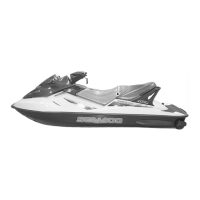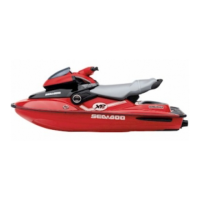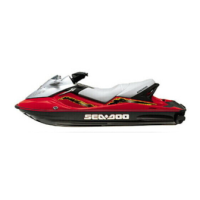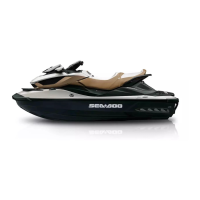What does it mean if my Sea-doo RX DI 2002 is making abnormal noise from propulsion system?
- MMichele YoungSep 8, 2025
Abnormal noise from the propulsion system of your Sea-doo Boat can be due to cavitation. Clean the area and check for any damage.

What does it mean if my Sea-doo RX DI 2002 is making abnormal noise from propulsion system?
Abnormal noise from the propulsion system of your Sea-doo Boat can be due to cavitation. Clean the area and check for any damage.
What does it mean if my Sea-doo RX DI 2002 watercraft engine cannot run above idle speed?
If your Sea-doo Boat watercraft engine cannot run above idle speed, the monitoring system may have put the watercraft in limp home mode due to a component malfunction (DI models). Try removing and reinstalling the safety lanyard on its post.
What does it mean if my Sea-doo Boat beeps twice every minute?
If your Sea-doo Boat (RFI models) beeps for 2 seconds every minute, it indicates that the fuel tank level is low. Refill the fuel tank.
What does it mean if my Sea-doo RX DI 2002 beeps for 2 seconds every 15 minutes?
If your Sea-doo Boat (DI models) beeps for 2 seconds every 15 minutes, it means the oil injection reservoir level is low. Refill the reservoir.
| Manufacturer | Sea-Doo |
|---|---|
| Model | RX DI |
| Year | 2002 |
| Category | Personal Watercraft |
| Engine Type | 2-Stroke |
| Engine | Rotax 947 |
| Displacement | 947 cc |
| Horsepower | 130 hp |
| Seating Capacity | 2 |
| Fuel Capacity | 15.9 US gallons |
| Fuel System | Direct Injection |
Basic rules for safe operation and enjoyment of the watercraft.
Guidelines for safe operation, including PFD use, clothing, and maneuvers.
Procedures for keeping the watercraft in top condition and following schedules.
Defines warranty coverage, period, and conditions for North American models.
Process for claiming warranty service and transferring ownership coverage.
Lists items not covered by warranty and liability limitations.
How to get help and specific emission warranty for California models.
Defines international warranty coverage, period, and requirements.
Process for international warranty claims, exclusions, and limitations.
Provides instructions and illustration for finding the watercraft's registration number.
Explains how to find Hull and Engine Identification Numbers.
Illustrates the location of controls and components on GS models.
Illustrates the location of controls and components on XP models.
Illustrates the location of controls and components on GTI/GTI LE models.
Illustrates the location of controls and components on RX Series models.
Illustrates the location of controls and components on GTX Series models.
Explains the function and use of the safety lanyard and DESS system.
Details handlebar controls for steering and related functions.
Explains throttle lever acceleration and shifter lever for gear selection.
Describes the engine start/stop button and Variable Trim System functions.
Explains the function of gauges, fuel level, and the multifunction information center.
Details access to storage, fuel tank valve, cap, and oil reservoir.
Explains access to tool kit, air intake, seat latches, and covers.
Describes eyelets, cleats, boarding aids, and bleed outlets.
Explains the jet pump nozzle, reverse gate, water intake, and bilge systems.
Covers fuse identification, battery location, and side vane function.
Step-by-step instructions for safely fueling and recommended fuel types.
Lists correct oil types and explains the oil injection system.
Details the required break-in period and specific procedures for different models.
Recommends a 10-hour inspection by a dealer for initial checks.
Provides a checklist of items to inspect before operating the watercraft.
Explains how the watercraft's propulsion system works.
Guidance on riding, stopping, and handling different water conditions.
Instructions for safely boarding the watercraft from docks or in water.
Step-by-step guide for starting the engine, including cold/warm procedures.
Instructions for safely shutting down the engine.
Daily procedures for cleaning and protecting the watercraft, plus special care for salt water.
Procedures for flushing the cooling system and lubricating engine parts.
Steps for applying anticorrosion protection to metallic parts.
Explains the monitoring system, coded signals, and limp home mode functions.
Procedures for engine overheating and cleaning the jet pump intake.
Steps to take if the engine becomes water-flooded or fuel-flooded.
Precautions for towing and advice on low-charge battery conditions.
Details on manufacturer, dealer, and owner responsibilities regarding emissions.
Explains lubrication steps for PTO flywheel and protection for cables/connections.
Importance of routine maintenance and inspection schedules.
Instructions for inspecting cables, adjusting carburetors, and replacing filters.
How to check steering alignment and adjust the Variable Trim System.
Information on locating, checking, and replacing fuses in MPEM and rear box.
Procedures for inspecting the engine compartment and cleaning the watercraft.
Guidelines for safely trailering, launching, and loading the watercraft.
Recommendations for storing the watercraft, including engine draining.
Instructions for installing and disconnecting hoses for maintenance.
Detailed steps for cooling system antifreeze and anticorrosion treatment.
Final actions before storage and tasks for pre-season preparation.
Explains beeper codes and remedies for engines that won't start.
Troubleshooting for misfires, overheating, pinging, and lack of power.
Solutions for issues with acceleration, idle speed, top speed, and O.P.A.S. system.
Troubleshooting for abnormal noises from the propulsion system.
Technical specifications for the GS model watercraft.
Technical specifications for the XP model watercraft.
Technical specifications for GTI/GTI LE and GTX models.
Technical specifications for the GTX RFI model watercraft.
Technical specifications for RX and RX DI models.
Provides conversion factors between SI and imperial units.
Lists and defines abbreviations used throughout the manual.











